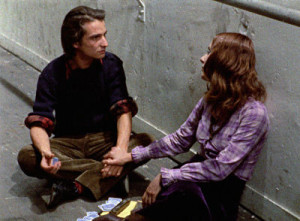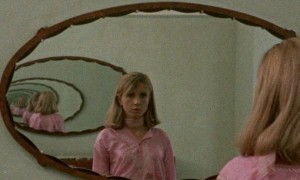STUDIO: Carlotta | DIRECTOR: Jacques Rivette | CAST: Jean-Pierre Leaud, Juliet Berto, Michael Lonsdale, Bulle Ogier, Michelle Moretti, Bernadette Lafont
RELEASE DATE: 1/12/16 | PRICE: DVD and Blu-ray $99.95
BONUSES: feature-length documentary, 118-page booklet with essays and interviews
SPECS: NR | 1149 min. | Foreign language drama | 1.33:1 widescreen | mono | French and English with optional English subtitles
The least-known member of the French New Wave, Jacques Rivette (Around a Small Mountain) deserves a much bigger cult following in the U.S. Hopefully this beautifully packaged release of Out 1, his most “notorious,” experimental and uniquely inventive project — shot in 1970, but not fully edited until the Nineties and not shown internationally until the 2000s — will help bring him a bigger fan base.
Granted, Out 1 is not an easy viewing experience for its first episode. A nearly thirteen-hour hour miniseries in eight episodes bearing the subtitle Noli me tangere (Latin for “don’t touch me”), the film starts out with lengthy rehearsal sequences showing two theater troupes “loosening up” with oddly tribal dances, improvisational experimentation and ritualistic game-playing.
Much like another epic-length masterwork, Berlin Alexanderplatz, once one has made it past the first difficult episode, it’s all downhill from there, as Rivette turns the proceedings into an absorbing character study with thriller (and even comedic) aspects. It is not the best introduction to Rivette’s work, as it requires a serious investment of time and an interest in non-conventional storytelling. Its release on DVD, though, is a major cinematic event, since the film is now (finally) able to be seen at the viewer’s discretion (its showings in the U.S. have been marathon events).
The plot isn’t easily summarized, but it revolves around two drifters and their interactions with the theater troupes. Colin (Jean-Pierre Leaud, Day for Night) is a sidewalk beggar who stumbles onto a conspiracy — a mysterious “group of 13” who are plotting to take over Paris. In the meantime, a crafty grifter (Juliet Berto, Weekend) gets herself in deep trouble while trying to carry off blackmail schemes.
Rivette shifts effortlessly between several different protagonists. The length of the series ensures that the viewer becomes familiar with the central characters and is drawn slowly into the conspiracy storyline.
One of the most impressive elements of Rivette’s work is its pacing — his lengthier films start off slowly (and seem mildly confusing at first), but then begin to speed up, with genre elements appearing. Here, for instance, Berto’s plotline moves from being a seemingly unnecessary sidebar to an all-out action movie with a final Feuillade-like showdown on the roofs of Paris.
Out 1 is also the most thorough exploration of one of Rivette’s favorite themes, the discovery of a conspiracy that drives a character mad. Leaud’s character seems somewhat loopy to begin with, but his efforts to figure out who is in the “group of 13” and what their aims are produce some wonderfully memorable scenes, including an incredible moment where he feverishly recites an odd variant on Lewis Carroll’s “The Hunting of the Snark” as he walks through the streets of Paris.
While the series is clearly “about” several things — among them the line between performance and reality, and the way in which artists play games in order to create their work — one question seems to drive all its action: after the political eruptions and cultural explosions of the Sixties, what now? The characters here (save the two drifter figures) are all depicted as former radicals who are not certain how to channel their energies, so they seek “answers” through staging plays by Aeschylus.
As with all of Rivette’s best work, Out 1 was tailored to the talents of its stars, who in this case improvised their own dialogue. The two standouts are Leaud, in his manic, OCD, Godardian aspect, and pout-queen Berto, who wonderfully conveys her character’s whimsical (and mostly inept) criminal instincts.
The other two leads, whose characters are “insiders” with knowledge of the “13,” are equally sublime at fleshing out their roles. Michael Lonsdale (Park Benches) is the most dominant presence in film as the charmingly egomaniacal leader of the more rigid of the two theater troupes. Rivette stalwart Bulle Ogier (Le Pont du Nord) is equally memorable as a haunted woman whose missing activist husband was deeply involved in the conspiracy. She tethers the film solidly to Sixties culture, as she runs a trippy boutique at which political radicals gather (where they run — what else? — an underground newspaper).
The Out 1 box set contains both Blu-ray and standard DVD versions of all its contents (six Blu-rays and seven DVDs). Rivette’s four-and-a-half-hour theatrical version of the series, called Out 1: Spectre, is also included. It contains many of the best sequences and provides an excellent abridgement of the material. (Rivette maintained that Spectre took him much longer to assemble than the miniseries.) The most interesting thing about the theatrical feature is that it doesn’t include the rather pungent conclusion of Leaud’s plotline and instead “points the way” to the series.
Robert Fischer and Wilfried Reichart’s Mysteries of Paris is an excellent feature-length documentary that both explains and contextualizes Out 1 (but is certainly not to be watched until one has already seen the series). The documentarians unlock a lot of the plot twists in the film through two very rare interviews with Rivette about the project and several new interviews with the surviving cast members (minus Leaud, who rarely consents to interviews). Producer Stephane Tchal Gadjieff also offers a history of the rare public screenings of the full series, which was shown only at festivals as a work print until the Nineties.
Rivette connects the film to the post-Sixties quandary mentioned above when he notes in one clip that he began conceiving of Out 1 shortly after the political upheavals of May ’68 in Paris. He also emphasizes how much he wanted to work with certain members of the cast, to the extent that he required them to come up with their own dialogue for the characters. (It’s interesting to remember that, despite his having been a filmmaker and critic for well over a decade by this point, Rivette still had only three features to his credit by 1970.)
The cast members talk in much depth about the daunting nature of improvising their dialogue on camera. Ogier mentions an incident in which she and Bernadette Lafont (Le beau Serge) were at a loss as to what to say. They thus spoke in ambiguous terms about something bothering them, and the result is a memorably paranoid sequence that wound up in the final edit of the series.
Despite its improvised dialogue, Rivette was insistent that the film was in fact tightly structured. He precisely diagrammed the encounters between the characters and made certain that the actors knew whether they were inside or outside of the “13.” The improvised dialogue did lend an element of chance to the proceedings, but Rivette’s ultimate plan for the film ensured that the plot threads could only be resolved in certain specific ways.
The final item in the box set, a 118-page booklet (with all content in both English and French), clears up all the mysteries that are not addressed by the documentary. It contains reminiscences of the film from all its stars (including Leaud) taken from old interviews. There is also a piece on the restoration of the series (which, Rivette notes, didn’t have opening or closing credits until the Nineties), plus an interview with Rivette, wonderful on-location photos by Pierre Zucca, and an incisive essay by Rivette cultist Jonathan Rosenbaum.
Perhaps the nicest inclusion is a “fan” letter to Gadjieff from Rivette’s old Cahiers colleague Eric Rohmer (who has a small but important role in the film as an expert Leaud quizzes about the “13”). He rightly calls Out 1 “a capital monument in the history of modern cinema.”
|
Buy or Rent Out 1
|
|||
|---|---|---|---|
 |
|||


Leave a Reply